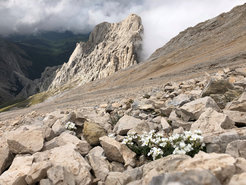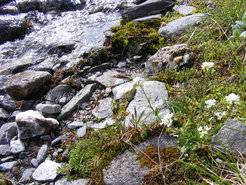Plant population genetics and adaptation genomics
Introduction
In natural plant populations, plants often differ in their genomic DNA sequence. Some of these differences are neutral, that is, do not have an effect on plant performance in the natural environment (fitness). Other variants influence phenotypic traits, and can have a negative or a positive effect on survival or fecundity, and therefore evolve under the effect of natural selection. In the group, we study how genomic variation in plants originates and evolves through time and space, as a result of mutation, recombination, genetic drift, migration and selection. In turn, the configuration of variants across the genome retains information on the past history of populations and species. This information ranges from the place of origin of a species, the degree and timing of isolation across populations, population size expansions and contractions, admixture, and adaptation to ecological and environmental conditions. We analyze large-scale genomic data to retrieve this information and reconstruct past events in the biogeographic and evolutionary history of plants (see for example, Durvasula et al. 2017, Fulgione et al. 2018, Fulgione et al. 2022). Understanding the history of past adaptation in plants can help us build a framework to predict future responses to climate change, and to understand the stability of natural and agro-ecosystems.
Research aims
Research in the group focuses on population genetics, genomics and evolutionary biology of plants, with the main aim of understanding adaptation to the biotic and abiotic environment. We use methods in computational biology, bioinformatics and modelling applied to large-scale genomics data, in combination with the study of molecular function, plant phenotype and fitness in controlled experiments and in natural conditions.

Research in the group currently focuses on the perennial, Arctic-alpine species Arabis alpina (Fig. 1 and Fig. 2), which has several advantages complementary to A. thaliana and other model plants and crops (Wötzel et al. 2021). First, the perennial life-history and its developmental and evolutionary consequences have not been studied as systematically as in annuals. In the group we are exploring the consequences of life-history strategies on the evolution of plant genomes. Further, A. alpina is found in Arctic-alpine environments across a wide geographic range, which represents a deep history of colonisations across the continents, and provides the potential for local adaptation. The Arctic-alpine environment is extremely harsh, with prolonged frost, drought, high UV irradiation and a short growing season, likely resulting in strong selective pressures. A. alpina is therefore a powerful model to study biogeographic dynamics and genomics of adaptation to natural, harsh environments. A. alpina also shows unusual variation in mating system, with outcrossing, mixed mating, and selfing populations across the range. These populations also vary in selfing syndrome traits, a set of reproductive traits associated with mating system variation in plants (e.g., flower size, pollen count, and floral scent). In the group we use population genomics to study the evolution of variable mating systems, of mixed mating strategies, and of selfing-syndrome traits. Finally, A. alpina accessions show phenotypic variation at ecologically relevant traits related, for instance, to the perennial life-history, to the variation in mating system, and to adaptation to the harsh Arctic-alpine environment.
We are building a large panel of natural genomic and phenotypic variation in A. alpina, which will support projects focused on local evolutionary scenarios, on populations with potentially adaptive phenotypic peculiarities, as well as projects with a species-wide focus. Currently ongoing projects are:
Demographic and biogeographic histories of A. alpina
As in our previous work in Arabidopsis thaliana (Durvasula et al. 2017), large-scale genomic data can be used to refine our understanding of the origin of species, the timing and pattern of their migrations across the continents, changes in population size, isolation and mixing. Our current knowledge of A. alpina history is based on phylogenetic analyses of some loci (Koch et al. 2006; Ehrich et al. 2007; Ansell et al. 2011; Karl et al. 2012) or to the last interglacial (the last 10-20 thousand years) and the European continent (Laenen et al. 2018). In this project we use a novel large-scale panel of population genomics diversity for A. alpina (upwards of 1000 genomes) to reconstruct its demographic and biogeographic histories.
Ecological adaptation of flowering phenology in perennial plants
In a previous collaborative project on the flowering phenology in European A. alpina, we found peculiar flowering phenotypes in Spanish populations, which flowered late, had a strong vernalization requirement, and a short duration of flowering (Wunder et al., under review). This contrasts with known clines in the annual plant A. thaliana, where late flowering is more prevalent at high latitude (Stinchcombe et al., 2004) and altitude sites (Méndez-Vigo et al., 2011), suggesting intrinsically different evolutionary forces at play. In this project we have sequenced the genomes of around 300 Spanish accessions to understand the history, adaptive value, and genetic basis of the unusual flowering phenology of these populations.
Population genomics of variable and mixed mating system

Since the seminal work of Darwin, the evolution of mating system and reproductive strategies remains a fascinating topic in evolutionary biology. In particular, the adaptive significance of variable and mixed mating strategies is still controversial (Goodwillie et al. 2005). In this project we study the evolutionary dynamics that govern variable mating system and mixed mating strategies in A. alpina, and the selective forces involved in the evolution of selfing syndrome traits (see Fig. 1 and Fig. 2). We use large scale, short-reads genomic data from our collection of European populations of A. alpina, which unusually varies in mating system and in selfing syndrome traits, in combination with long-reads assemblies (30 genomes) and genetic mapping from crosses.
Adaptation of perennial A. alpina along a latitudinal gradient in Scandinavia
In this project we will reconstruct the history of postglacial colonization of Scandinavia, and of adaptation to the stressful high-latitude environments that allow only very short growing seasons. We will use a combination of population genomics on a data set of around 300 genomes from across a latitudinal transect in Scandinavia, and genome-wide association analyses to study the genetic architecture of adaptive traits. Further, we will assess whether plants are adapted to specific locations by performing reciprocal transplant experiments and by scoring plant traits in situ.
This project is funded by the DFG within the SFB TRR 341 "Plant Ecological Genetics".
Want to join the group?
If you are interested in joining the group, contact me at fulgione@mpipz.mpg.de. At the moment we have an opening for a Ph.D. and a postdoc positions. If you have exciting project ideas that fit in the group we can also discuss possibilities to apply for funding for your project.
Selected publications
A. Fulgione, C. Neto, A. F. Elfarargi, E. Tergemina, S. Ansari, M. Göktay, H. Dinis, N. Döring, P. J. Flood, S. Rodriguez-Pacheco, N. Walden, M. A. Koch, F. Roux, J. Hermisson, and A. M. Hancock. Parallel reduction in flowering time from de novo mutations enable evolutionary rescue in colonizing lineages. Nature Communications, 13(1):1461, March 2022. ISSN 2041-1723. doi: 10.1038/s41467-022-28800-z.
E. Tergemina, A. F. Elfarargi, P. Flis, A. Fulgione, M. Göktay, C. Neto, M. Scholle, P. J. Flood, S. Xerri, J. Zicola, N. Döring, H. Dinis, U. Krämer, D. E. Salt, and A. M. Hancock. A two- step adaptive walk rewires nutrient transport in a challenging edaphic environment. Science Advances, 8(20):eabm9385, May 2022. ISSN 2375-2548. doi: 10.1126/sciadv.abm9385.
M. Göktay, A. Fulgione, and A. M Hancock. A New Catalog of Structural Variants in 1,301 A. thaliana Lines from Africa, Eurasia, and North America Reveals a Signature of Balancing Selection at Defense Response Genes. Molecular Biology and Evolution, 38(4):1498–1511, April 2021. ISSN 1537-1719. doi: 10.1093/molbev/msaa309.
A. Fulgione, M. Koornneef, F. Roux, J. Hermisson, and A. M. Hancock. Madeiran Arabidopsis thaliana reveals ancient long-range colonization and clarifies demography in eurasia. Mol Biol Evol, 35(3):564–574, 2018. doi: 10.1093/molbev/msx300.
A. Durvasula*, A. Fulgione*, R. M. Gutaker, S. I. Alacakaptan, P. J. Flood, C. Neto, T. Tsuchi- matsu, H. A. Burbano, F. X. Pico, C. Alonso-Blanco, and A. M. Hancock. African genomes illuminate the early history and transition to selfing in arabidopsis thaliana. Proc Natl Acad Sci U S A, 114(20):5213–5218, 2017. doi: 10.1073/pnas.1616736114.
*: equal contribution, first authors
To see the full list of publications, see the following link

